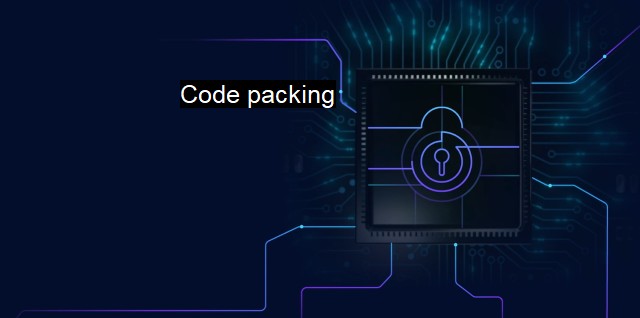What is Code packing?
Code Packing: A Dangerous Cybersecurity Practice Used by Malware Designers and Cybercriminals
Code packing is a technological concept often encountered in discussions surrounding cybersecurity and antivirus strategies. It is an essential notion utilized by both cyber attackers and defenders, highlighting the need for its understanding in the realm of cybersecurity.Code packing, also frequently termed as software packing or executable packing, is the process of compressing an executable file and appending the unpacking code at the start of this file. Such a procedure is likened to shipping goods that are packed to avoid damage, and, in the case of actual software, to diminish file sizes and protect the data they hold. Smaller file sizes ease software delivery from developers to users, decrease bandwidth consumption, and reduce storage space, thereby making distribution more efficient.
Code packing does not only offer benefits. While it enhances software distribution, it can also be exploited by cyber attackers for malicious purposes. This is called malicious code packing, which disguises harmful software (malware) as harmless. With malicious code packing, apart from compressing files to serve their schema, cybercriminals also make their malware difficult to detect. Hackers pack their programs into a form that allows the malware to sneak through the security checks undetected, behaving like a wrapped box hiding the evil inside.
Given the mutable shape of the malware, it is hard for antivirus software to identify these threats. Most methods that antivirus software employs to detect malware involve the analysis of the code, searching for specific patterns that relate to known malware. In unpacked executables, malicious code is readable directly from the binary. this methodology does not work with packed malware as the nefarious content is encrypted and concealed, only getting unpacked when it infiltrates a system.
Indeed, the employment of packed software plummets the accuracy of detection by heuristic analysis, signature comparison, and pattern identification. with polymorphism and metamorphism technologies, which constantly amend the coding structure of the malware and the packing process, each packed version looks different and is effectively a novel, never-seen-before entity. Hence, packed malware appears to be innocuous, slips into systems effortlessly, and deals damage behind the lines of protection.
In response to these malicious practices, cybersecurity professionals and antivirus producers adopt several defensive strategies. A common approach is unpacking the packed executables in a guarded environment (sandbox) and inspecting the unpacked codes for malicious characteristics. Just like seeing through a package's cover to decipher what is underneath, security officers unpack the compressed code to peruse its nature. Cyber defenses are also using behavioral analysis, watching for activities characteristic for malware, such as surreptitious access to sensitive data or tampering system's processes, to detect encapsulated malware.
In sum, code packing is a technological process that impacts the distribution of software and the manifestation of malware. Seemingly a double-edged sword, it brings utility and security risks to software users at once. While packed software reduces file size and could conserve bandwidth and storage, disastrous consequences may arise when packed executables slip through cyber defenses without getting caught. This reinforces the importance of understanding code packing and developing solid resistance mechanisms against its plausible exploits fine-tuned for vindictive intentions. Unflagging vigilance and unwavering bolstering of security appear to be the only resolution in the increasingly proliferative use of packed codes.
Thus, the technology of code packing will persistently challenge the methods of malware detection. Antivirus producers, security analysts, and digital forensics experts will need to keep adapting and improving in this enduring cat and mouse game. Throughout this evolution, remaining apprised about code packing and its ever-changing mechanics is and will be critical for maintaining robust security and addressing coming and unanticipated risks. For all users, mastering this knowledge defines how well they fortify their digital domains against potential cyber breaches.

Code packing FAQs
What is code packing?
Code packing is a method of compressing software code, also known as executable or binary code. The objective of code packing is to make it difficult to analyze and reverse-engineer the code.What is the purpose of code packing in cybersecurity?
Code packing is used in cybersecurity as a technique to evade detection by antivirus software. Packed code can be used to hide malware, viruses, and other malicious software from security scanners. Code packers can also encrypt or obfuscate the code, making it harder for security analysts to understand and detect the malware.Can code packing be detected by antivirus software?
Most modern antivirus software can detect code packing, but it depends on the specific packer used and how it was configured. Some packers are more sophisticated than others and can bypass antivirus detection.Is code packing legal?
Code packing is a legitimate technique used by software developers to protect their code from theft and piracy. However, it can also be used maliciously to hide malware and other malicious software. As such, code packing can be illegal if it is used for criminal activities.| | A | | | B | | | C | | | D | | | E | | | F | | | G | | | H | | | I | | | J | | | K | | | L | | | M | |
| | N | | | O | | | P | | | Q | | | R | | | S | | | T | | | U | | | V | | | W | | | X | | | Y | | | Z | |
| | 1 | | | 2 | | | 3 | | | 4 | | | 7 | | | 8 | | |||||||